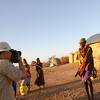
Faces and masks in the New Normal
The world won’t be the same after COVID-19. The way we will interact, work, play and rest will drastically change. Face covering is one of these fundamental changes, recreating who we are, how we are perceived. Beyond prevention, it changes the boundaries of ourselves, presents a shield and the possibility to sink into anonymity. Face masks draw new maps of social distance and proximity and are a new pedaof social relations and interactions. They open new windows of identity and representation. With half the face covered, we need to explore new ways of approach, retreat and distinction. With colored masks, elastic bands and medical ones, or self-made cloths, portraits in the new normality construct a multi-layered entity.
The use of the social and physical space has been affected, particularly in the street and the public transport, as it is the case with these collective portrays of young boys and girls in a popular neighbourhood in Nairobi, Kenya, which create a world of uncertainty that calls for a rapid understanding and adaptation.
Eduardo López Moreno, Mexico, Ciudad de Guadalajara